„Der Streif erlogner Meere“ – Observing mirages in central Europe
„Und immer ging es weiter,
Und immer ward es breiter,
Und unser ganzes Ziehen,
Es schien ein ewig Fliehen,
Blau, hinter Wüst und Heere,
Der Streif erlogner Meere.“
Johann Wolfgang von Goethe, West-östlicher Divan
„And ever on we haste,
Even some wider waste,
Till all our way and wending
Seemed but a flight unending
And blue, past wilds we flee,
Stretched the illusive sea.“
English translation by Edward Dowden (Learn more)
The quote comes from the first poem in the Book of Discontent (Rendsch Nameh) of the West-Eastern Divan (West-östlicher Divan). The collection of poems, published by the older Johann Wolfgang von Goethe (1749 – 1832) in 1819, is inspired by the works of the Persian poet Hafez (1325 – 1390). In the poem from which I am quoting, the apparent question posed to the poet is why, at his advanced age, he still engages with Persian poetry and allows it to inspire his own poetic creation. The answer suggests that the lyrical self opens up a new realm of life and finds itself rejuvenated in the process: „I was like newly born“ (in German: „Ich war wie neu geboren“). Images from a dangerous and colorful Bedouin life underscore this response.
However, like many of the poems—especially those written by the elder Goethe—it does not remain at the concrete level. Instead, the flow of the text moves far beyond an answer to the specific question, evolving into general reflections and meditations on life and human existence. In the end, reality and illusion seem to become indistinguishable. The final lines describe the experience of a mirage in the desert. This phenomenon evokes a sense of wonder: how often may it have misled helpless, „stranded“ travelers into believing that a life-saving body of water was just ahead?
Yet beyond the specific experience, these lines, in my view, point to something more. They invite repeated reading and recitation, prompting contemplation on the nature of reality and human perception. This is how it feels to me (Learn more).
The poem quoted at the beginning refers to a caravan and localizes the implied mirage in the desert. The references in the text to the poetry of the Persian poet Hafez make this assumption equally plausible. However, this optical phenomenon is also frequently encountered in other regions of the Earth. It can occur over land or over water when certain meteorological conditions are met. Generally, the optical basis of this phenomenon is the refraction of light rays as they pass through layers of air at different temperatures.
The optical phenomenon of mirage
In this short article, I’d like to provide an introduction to mirages and a few related atmospheric phenomena based on the refraction of light.
I will share a modest selection of images of mirages that I have photographed myself. While my collection is modest, there are many other photographers who have also captured stunning images of these phenomena. Notably, I encourage you to explore the extensive selection of images by Pekka Parviainen, a Lecturer in Mathematics at the University of Turku, Finland. His work showcases a wealth of manifestations of mirages that are truly remarkable. You can view his impressive collection on his website, see http://www.polarimage.fi/ and https://finland.fi/life-society/mirages-in-finland/ (Learn more).
Furthermore, I am indebted to Mr. Parviainen for his friendly and detailed response to an email inquiry regarding a question that I will address later.
Now let`s start with answering the question: What is a mirage?
Andrew T. Young from the Astronomy Department of San Diego State University, San Diego, CA, defines mirages as „real phenomena of atmospheric optics, caused by strong ray-bending in layers with steep thermal gradients“.
The French word „mirage“ has become the general term for this optical phenomenon, suggesting that a mirage is a mirror image of an existing object. Strictly speaking, we are not discussing an optical illusion. According to Andrew T. Young, mirages are „multiple images formed by atmospheric refraction“ (Learn more).
The physical cause of refraction is the bending of waves due to a change in the refractive index of the medium through which they pass. In materials with varying refractive indices, light travels at different speeds, causing it to bend at the boundary between two media. Light moves slightly slower in optically denser media (cold air) than in optically thinner media (warm air or air with lower density).
Besides mirages, there are other phenomena caused by refraction as well. To explore all of them, I encourage you to check out Andrew T. Young’s website Introduction to Mirages. Let me shortly mention the following ones:
- Looming – visibility of distant objects below the horizon
- Sinking – disappearance of objects below the horizon
- Towering – exaggerated vertical size
- Stooping – compressed flattened vertical size
While these phenomena can distort objects, they do not create multiple (inverted) images.
But let’s examine mirages in more detail. There are two different kinds of them:
Inferior mirage
An inferior mirage occurs when the sun-warmed ground surface creates a layer of hot air with low density directly above it, particularly noticeable on hot summer days when asphalt heats significantly. Light rays are bent upwards into the colder, denser air above this layer, producing an inverted image of distant objects, often seen near the horizon. This effect can make it appear as though there are puddles of water on the road, as the sky is reflected on the surface. This phenomenon is therefore also referred to as a „desert image“.
In Goethe’s West-Eastern Divan, the poet likely envisioned an inferior mirage when writing about the „Stretched … illusive sea“. This imagery reflects how travelers in the desert perceive the sky on the ground, simulating a body of water that seems within reach. While mirages are real optical phenomena, they create illusions because the reflected image is not what it seems. The German original, „Der Streif erlogner Meere“, emphasizes this deception, suggesting that the perceived sea is something false.
An inferior mirage occurs when the image appears below the actual object, leading to the illusion of water where there is none.
Superior mirage
This type of mirage can occur when the air is layered in the opposite way compared to an inferior mirage. Here, there is a warm layer of air sitting above a significantly cooler layer of air. This can happen when a cold layer of air is present over the sea, with warmer air above it. However, we also frequently encounter such conditions inland during inversion weather situations, when cold air (often with fog in the autumn) settles in the valleys while the air at higher altitudes is warm.
This causes light rays to bend downward, resulting in an elevated image of the object. Superior mirages can make distant objects, such as mountains or ships, appear higher than they actually are. A superior mirage occurs when the image appears above the actual object.
Further below, I will present a few photographs related to this phenomenon.
A Fata Morgana is a complex form of superior mirage visible in a narrow band right above the horizon.
It is important to note that mirages or Fata Morgana can never extend over a large part of the sky. They are always restricted to a narrow region of the sky at the horizon (Learn more).
As Andrew T. Young points out, to understand superior mirages, one must consider the curvature of the Earth. A strong temperature inversion creates a narrow atmospheric layer, or duct, where light bends downward more sharply than the curvature of the Earth itself. This phenomenon causes the light to become trapped within the duct, allowing it to refract continuously along the Earth's surface rather than escaping into space. As a result, distant objects can appear elevated or distorted, creating the illusion of visibility even when they are below the horizon.
Let’s now look at some real examples seen and photographed by the author in central Europe.
Mirages at the Coast
The following photo shows superior mirages seen at the coast of the English Channel at the shore of Le Touquet-Paris-Plage, France, in April 2025.
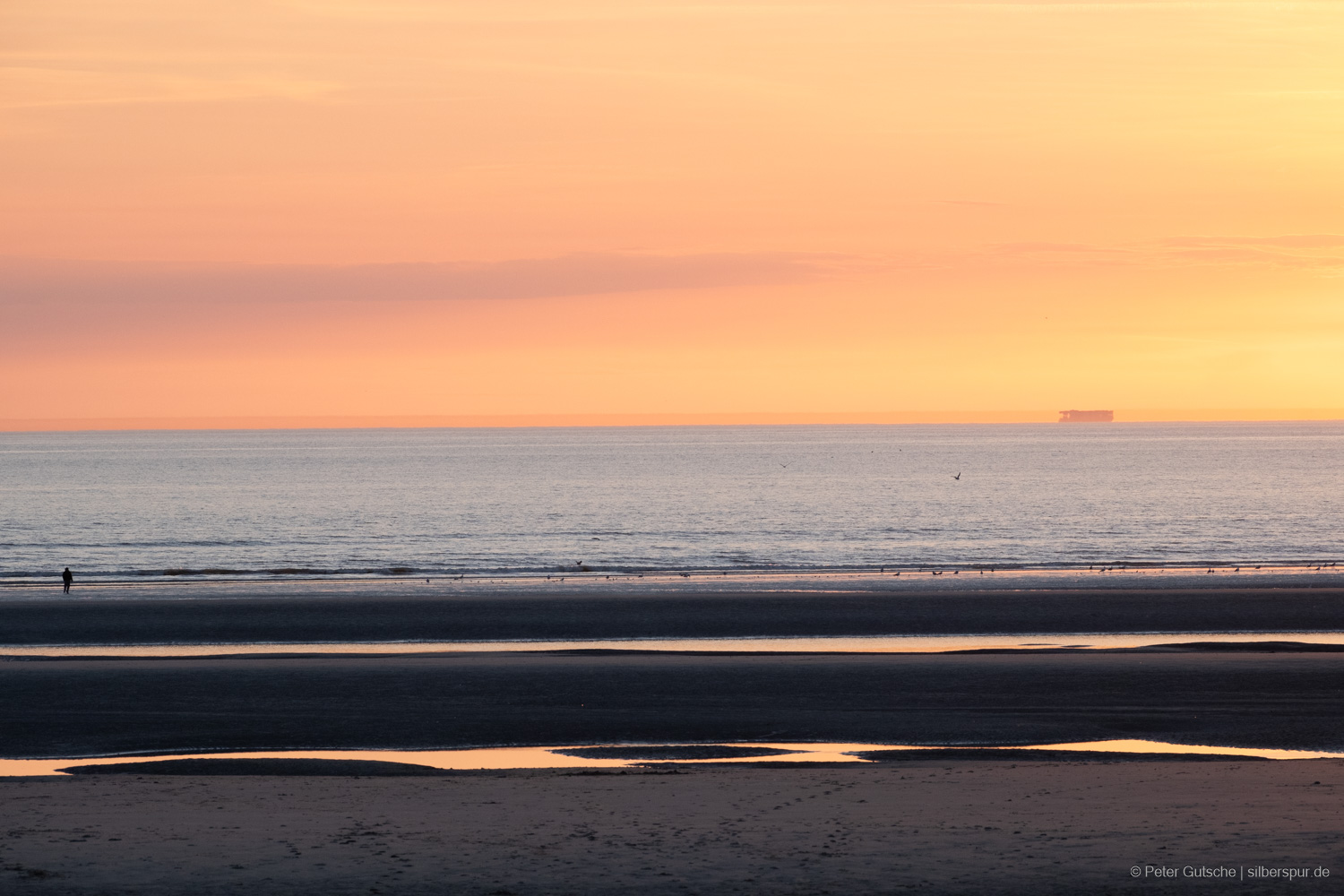
Here's a detailed section of this image.
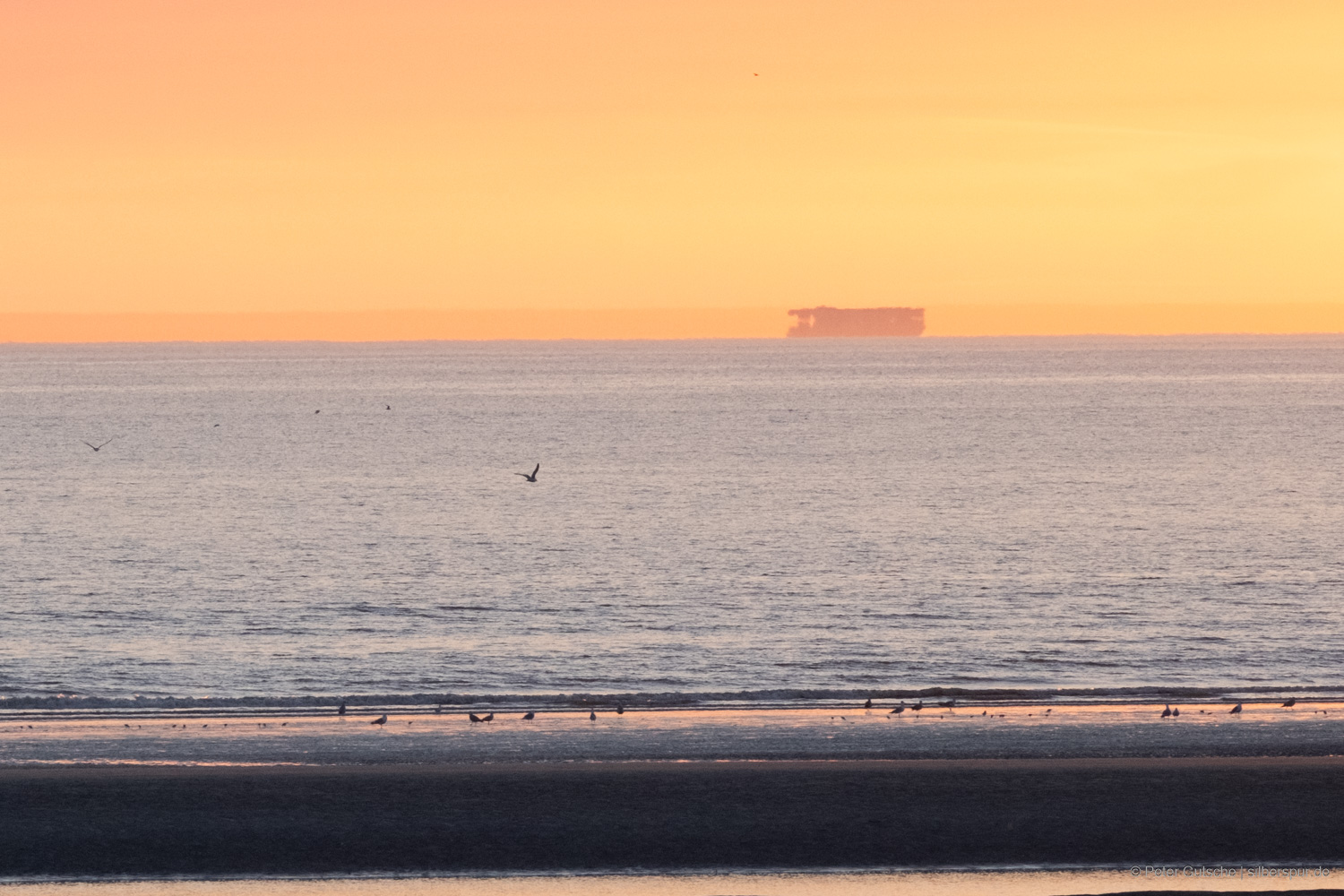
We can clearly see that the ship is reflected at a horizontal plane positioned slightly above its bottom, resulting in an overlap between the actual vessel and its mirrored image. This creates a „sandwich“ effect, where the two images blend together.
In the next photo, three distant objects can be seen, where a superior mirage is partially pronounced.
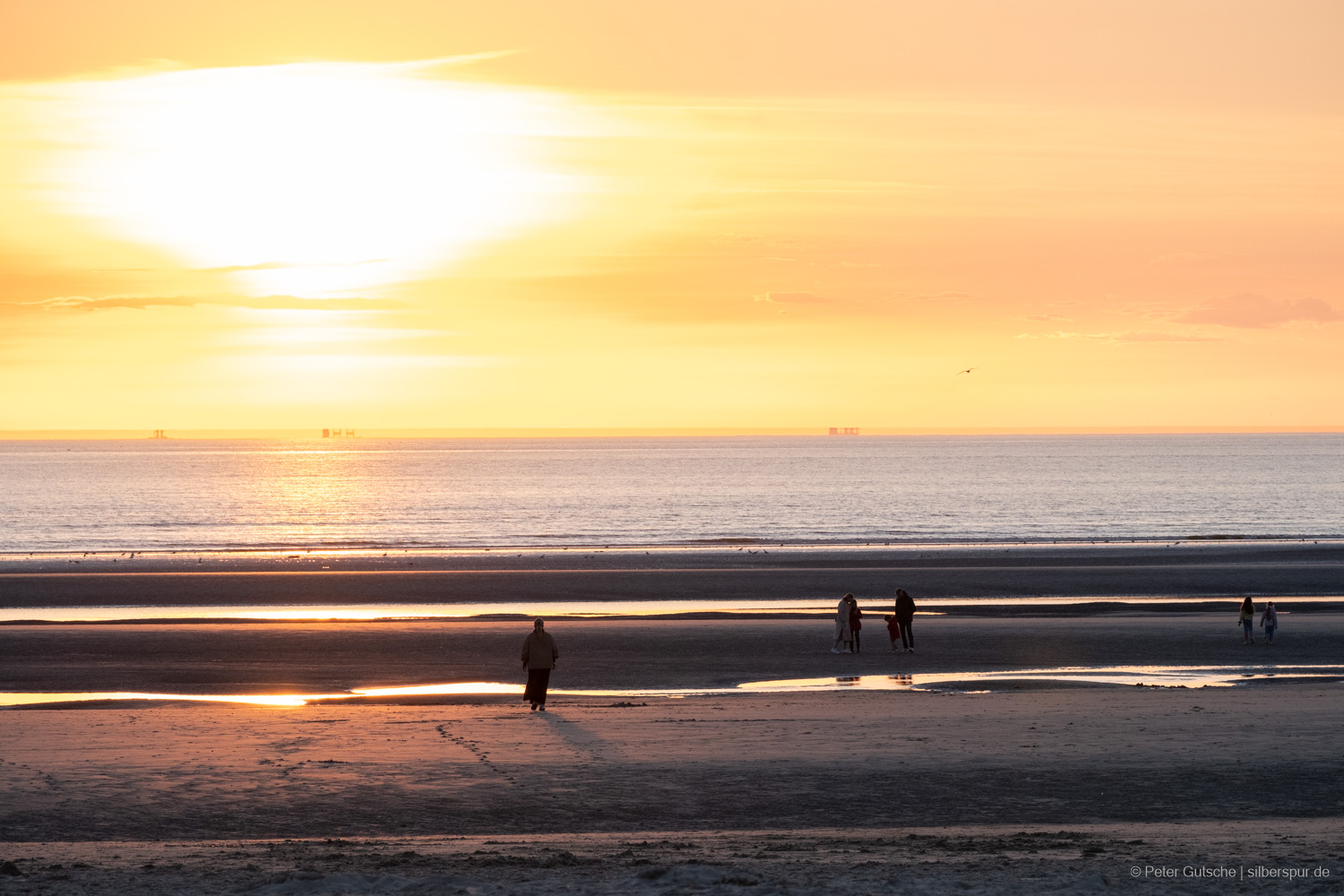
We can also observe that mirages change significantly with time and with the distance from the observer.
The following sequence shows the image excerpts from three photos taken fractions of a minute apart. As the objects moved over time, their distance from the observer also changed. This can explain why the mirage changed significantly in this sequence.

When you carefully examine the photos, the mirage effect appears distinct for the two objects, and its evolution over time differs as well. Superior mirages manifest and change differently depending on the distance between the object and the observer, as light rays from more distant objects pass through a greater portion of the atmospheric duct and are subject to stronger or repeated refraction. This concept becomes intuitively clear when you check out the ray diagrams on the page An Introduction to Mirages (Section The Superior Mirage) (Learn more).
Also the setting sun can be distorted by mirages. The following sequence of photos shows how the setting sun is distorted by the superior mirage (on the same evening as the photos above were taken).
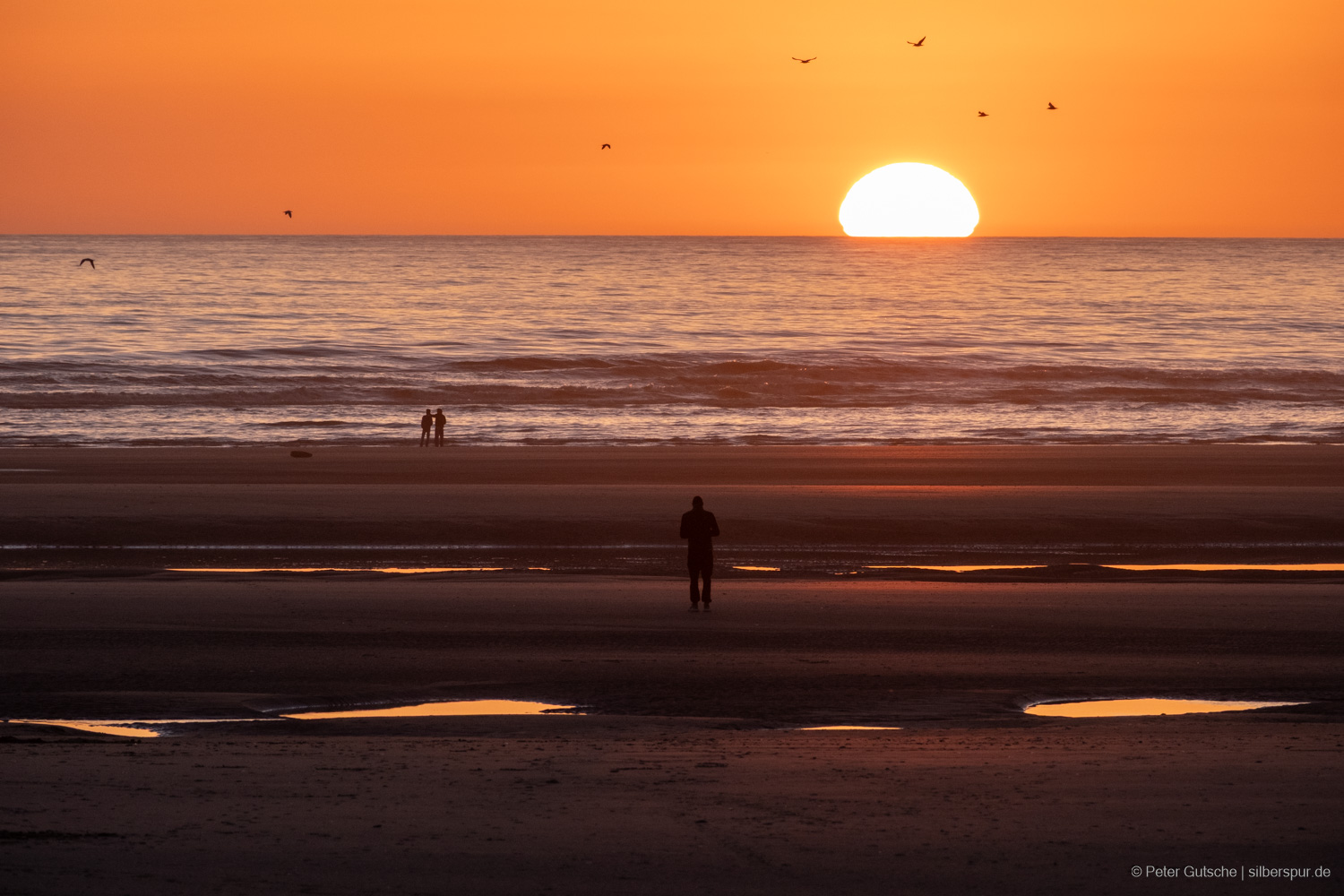
The following sequence shows sections with the setting sun from photographs taken within a time period of 2,5 minutes.

The image shows six photo excerpts of a sun setting over the sea at progressively later times (photos taken on the same evening like the previous photo was recorded). In the first image, the sun is still visible as more than half of its shape. However, the shape is flattened like an ellipsoid. In the first image, it can also be seen how the disk just above the horizon is deformed so that the sun appears narrower there. From image to image, the sun's disk becomes smaller, and the part just above the horizon is always deformed in different ways. Sometimes the disk directly above the sea is slightly wider and seems to „flow“ outward, while the area immediately above it appears slightly „dented“. The upper part of the sun's disk looks „normal“ and undistorted as long as the sun is still relatively high. However, once the sun has set significantly and only a small part of its disk is visible, the upper part of the disk also enters the „deformation area“, appearing to „flow“ outward. In the last image, where only a small part of the sun is still visible, the tiny upper area of the disk has detached from the rest of the disk and seems to be floating above it.
Let me now take you to another place further inland. There, too, one can observe mirages under certain weather conditions.
Mirages in the Black Forest
Buchberg (Southern Black Forest)
We spent the new year’s afternoon in 2013 in the Southern Black forest, Germany, not far from the Swiss border. We hiked to one summit east of the famous Wutach valley, the Buchberg, with an altitude of 876 meters. This place is located right at the eastern edge of the Southern Black Forest and borders the Hegau and Lake Constance region. The shot was taken in the southwestern direction.
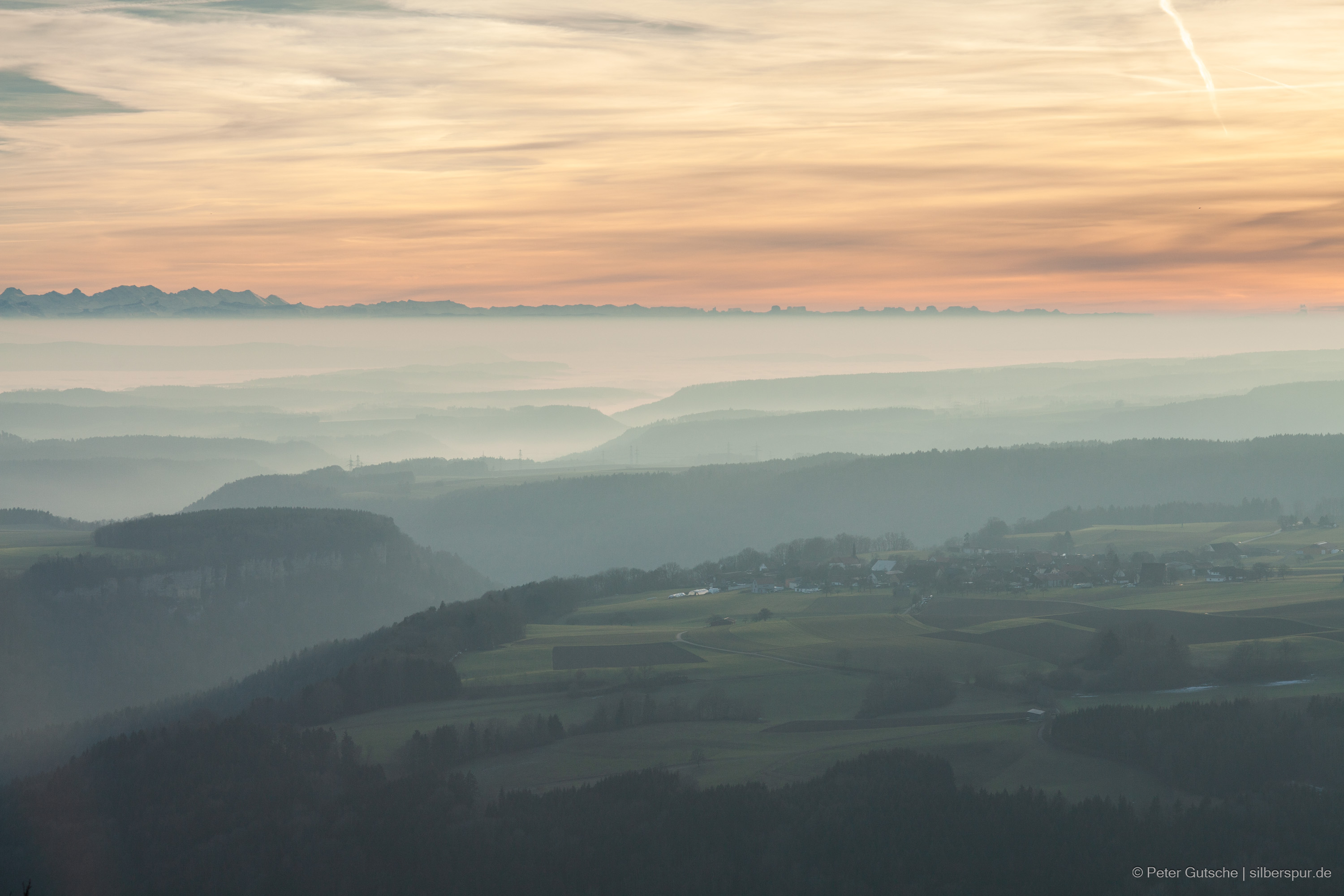
In the mid ground, you can see the lower hills and mountains of the Southern Black Forest (bordering the Upper Rhine Valley and Switzerland) – deeply incised by the Wutach River and its tributaries.
In the background, the photo shows part of the Bernese Alps on the far left. The striking mountain near the left edge of the image is the Bluemlisalphorn (3661 m) in a distance of 159 km. Before going into more details on which mountains you can see in the panorama, let me show you a shot taken about 20 minutes later from the same spot.
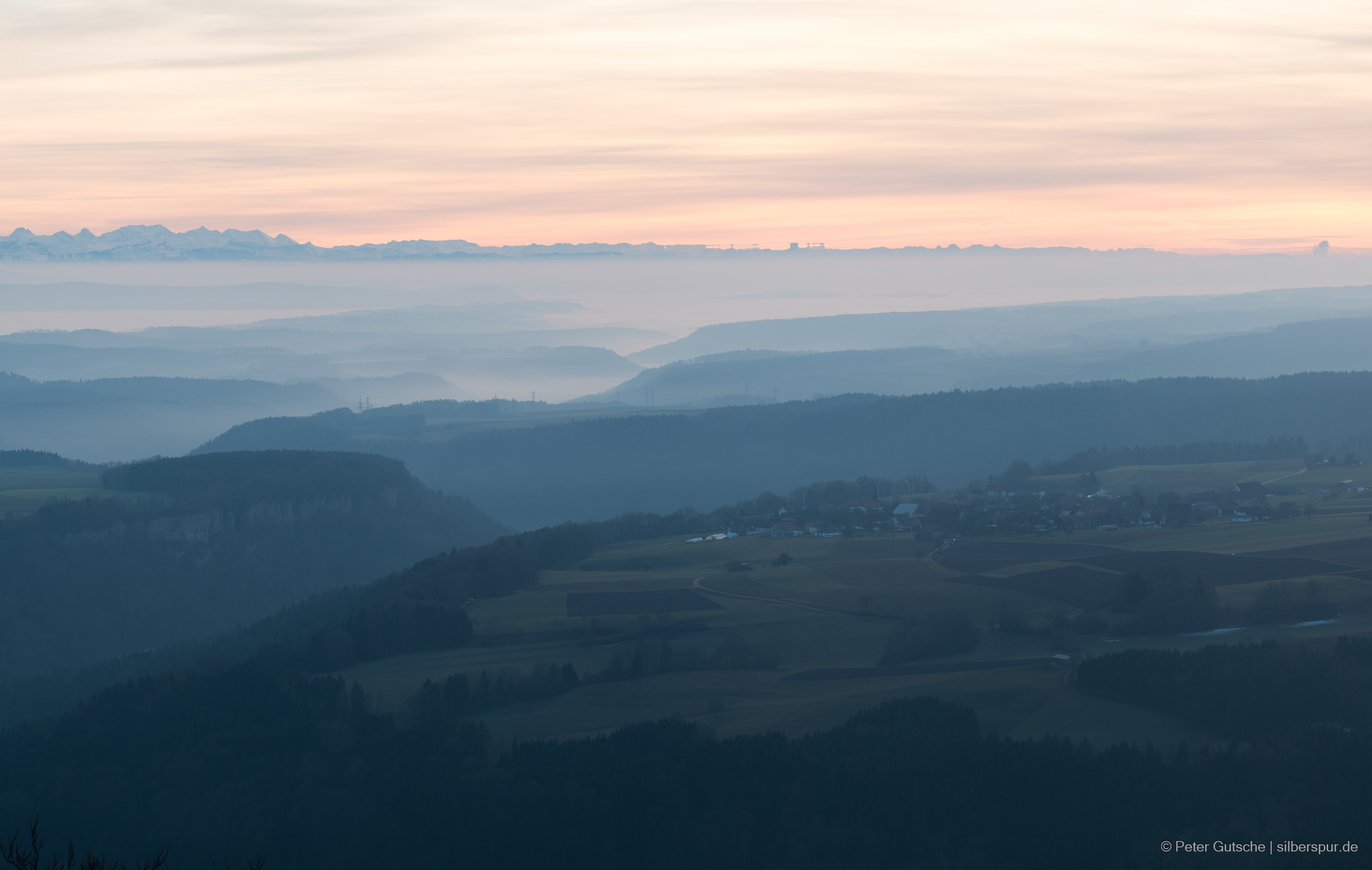
Besides the fact that it is dimmer now, on a first glance you might notice also a change in the Alpine mountain silhouettes quite in the mid of the picture. Take your time and also go back to the previous picture.
If you like to enjoy the whole beautiful panoramas taken at the two different times on New Year 2013 on Buchberg in high resolution, click these links:
https://www.silberspur.de/topics/panorama/pano-buchberg-alps.jpg
https://www.silberspur.de/topics/panorama/pano-buchberg-alps-02.jpg
Anyway, the silhouettes of the summits in the center of the photo seem to be distorted already in the first picture. In the second one taken 20 minutes later, you also notice some horizontal structures (strips) above some of the summits floating in the sky – as if parts of the silhouettes are mirrored and distorted. This is a faint mirage. This little exercise might also give an impression of the timescale on which such a phenomenon changes.
But let’s look into the panorama in a bit more detail. In the following figure I have put together both photos taken 20 minutes apart, together with some detailed sections of the distorted part of the panorama. I have also given the positions of some remarkable summits. To identify the different summits, I have used the panorama generation program developed by Dr. Ulrich Deuschle that you can find at https://www.udeuschle.de/panoramas/makepanoramas.htm (Learn more).
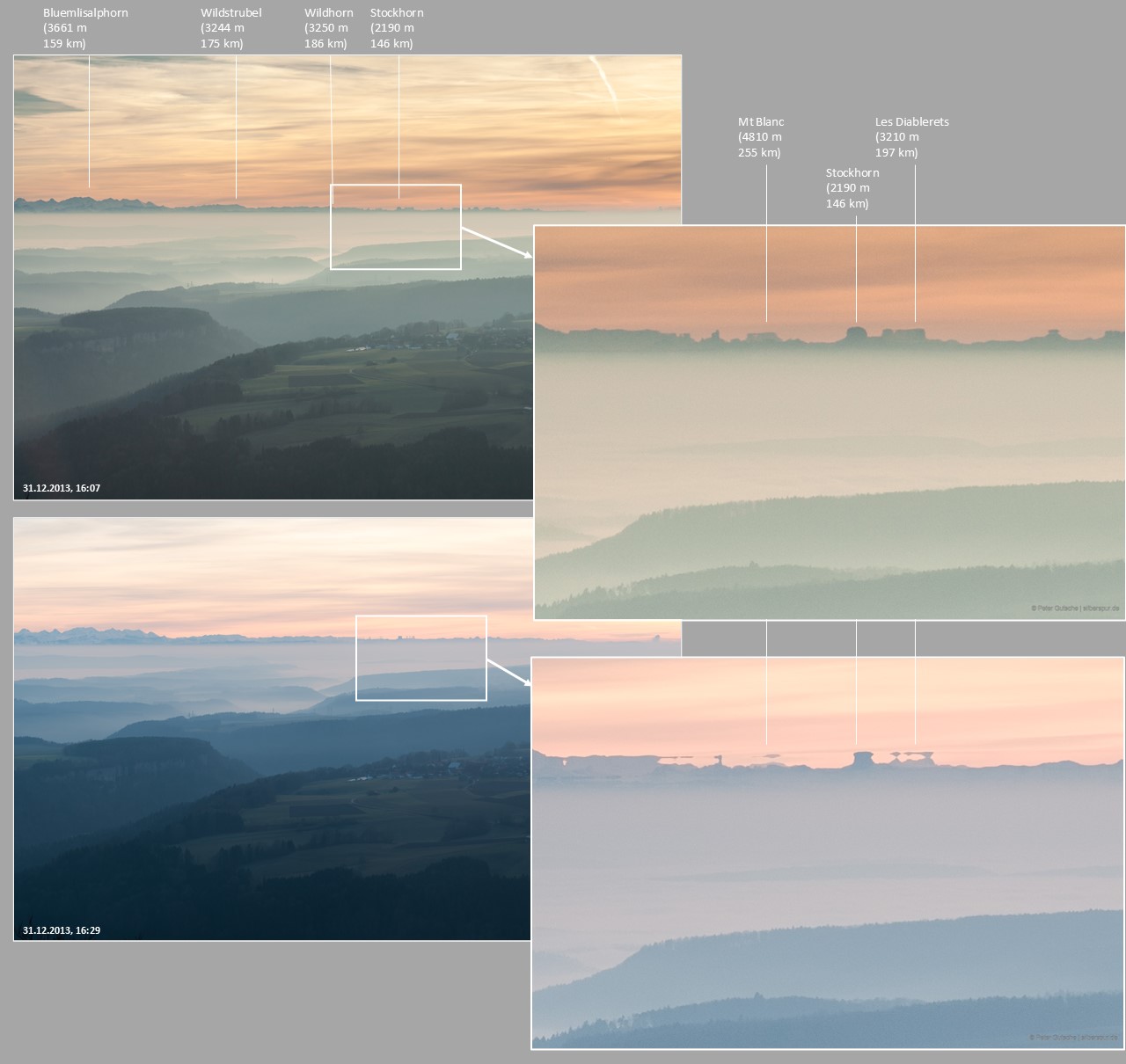
With this comparison, I’d like to make you aware, first, of how far you can see at some days from the mountains in the Black Forest. You can indeed see objects at a distance of over 200 kilometers in good visibility conditions. And, secondly, of the timescale on which mirages change. The inlays with the detailed section of the center of the image show you that in the first image (taken at 16:07) the mountains in the middle (notice the remarkable silhouette of the Stockhorn) are already distorted. I would assume (without having finally verified this) that this is the effect of towering: The mountain silhouette is distorted in a way that it seems to be extended a bit vertically. In the inlay related to the second image taken 20 minutes later, you notice in addition some very thin vertical stripes that seem to hover above the peaks in the center of the image, suggesting that the mountain base is partially reflecting above the peaks. This is a clear indication that we are already dealing with a superior mirage.
I would briefly talk about another interesting detail. As shown in the insets of the image before, the distorted mountain silhouette shows a summit which I have indicated as the very distant Mont Blanc and Les Diablerets – which are about 255, respectively 190 km away from the photo location. That is indeed the farthest mountain that can be seen from this viewpoint.
According to the panorama simulation done with the program provided by Dr. Ulrich Deuschle, the summit of Mt Blanc should be hardly visible, and only a tiny fraction be visible behind the range with the Stockhorn. But on the photos taken at an interval of 20 minutes the Mont Blanc mountain massif is very clearly visible. In particular, compare its shape on the first image taken at 16:07 where the shape is much higher than on the photo taken at 16:29 (see the inset).
The following photo shows the detailed mountain range taken at 16:03 where you even see a kind of mirrored shape on top of the Mont Blanc massive.
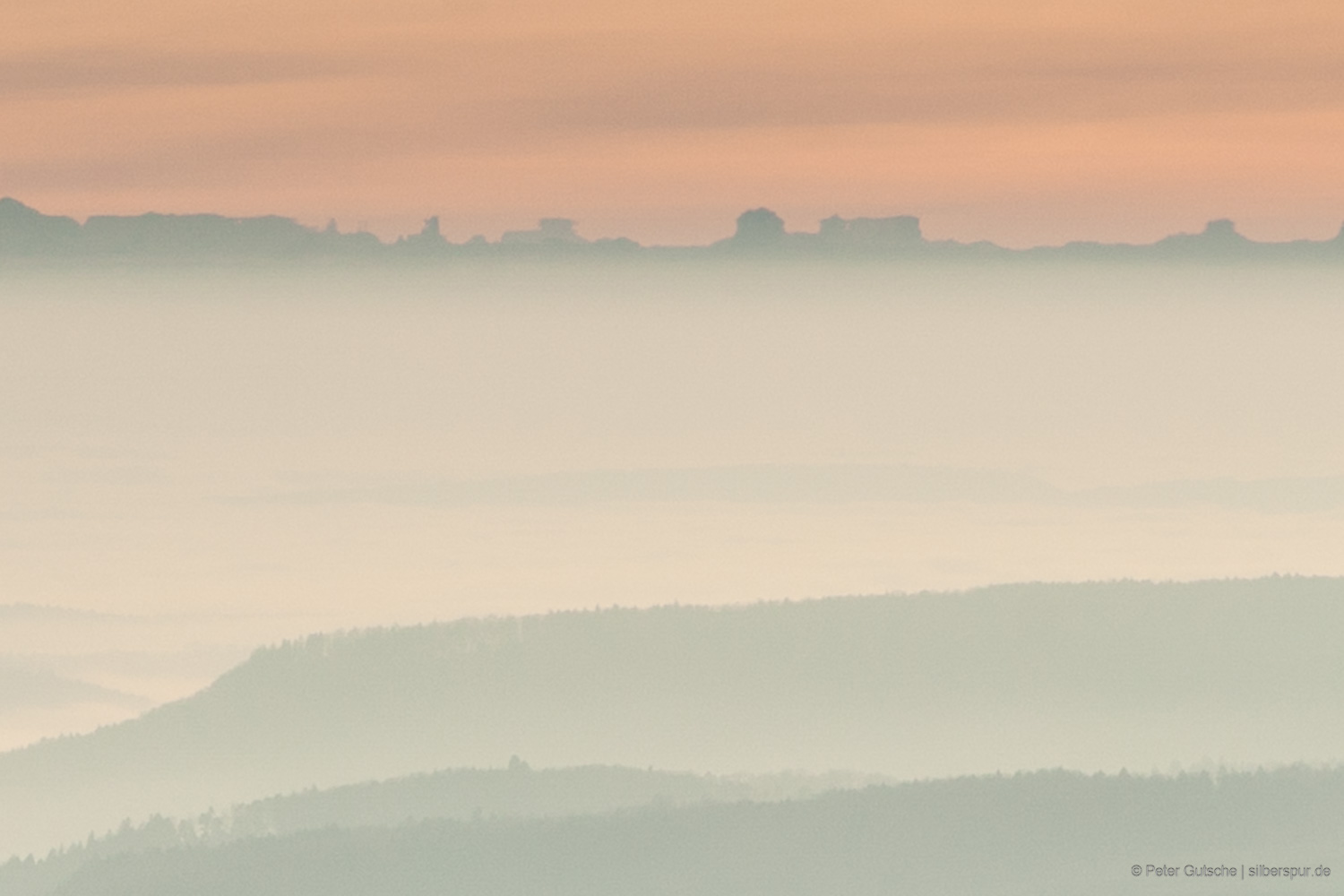
In this photo, the silhouette that we identify as the Mont Blanc massif is even more clearly visible, appearing vertically elevated. I conclude from this that mirages can cause objects that should largely be obscured due to the curvature of the Earth to still be more distinctly visible. In any way, this is highly plausible after what we have learned about atmospheric ducts in the beginning of this text.
Before coming to a last example, let me conclude the discussion of this one with some more very interesting aspects of mirages I have learned from a short personal email conversation with Pekka Parviainen. In the above shown photos you notice, as already discussed, that mirages change significantly over time (on a scale of minutes). Furthermore, it is obvious that different parts of the panorama change in slightly different ways. This might be explained either by an inversion layer with an undulating altitude; meaning: the height of the inversion layer changes depending on the direction you look. Another reason could be that the visible shapes of various mountains are affected in distinct ways due to their varying distances from the observer. Check out the distances I have given for some of the mountain peaks in the image above.
There’s – according to Mr. Parviainen – another interesting aspect of mirages I was not aware of when taking this shot some years back: Superior mirages are extremely sensitive to the height of the observer – and here we are talking about a length scale of a few meters. That means, a great mirage which you observe from your standpoint might be unobservable when you just change the height of your standpoint by a few meters. When I have the opportunity to see mirages next time, I will definitely test this behavior.
To citate from the website:
„superior mirages are often short lived due to wind, which is born at shoreline and which very effectively mixes the inversion layer. One major obstacle in detecting superior mirage is also the height of the vantage point. A good display can be visible at certain height, while one meter higher or lower shows hardly any miraging.“
I would like to sincerely thank Mr. Parviainen once again for the friendly conversation.
Hornisgrinde (Northern Black Forest)
About 100 km further to the North, there’s another spot which allows for a magnificent views. This is the Hornisgrinde (1164 m), the highest peak of the Northern Black Forest. Here, we are 100 km farther away from the chain of the Alps. However, on some days – preferably when there’s an inversion condition in the winter season – you might be lucky to see the chain of the Swiss Alps.
The following photos show the view from Hornisgrinde to South East at three different times on the evening of 26.12.2006, at 17:23.
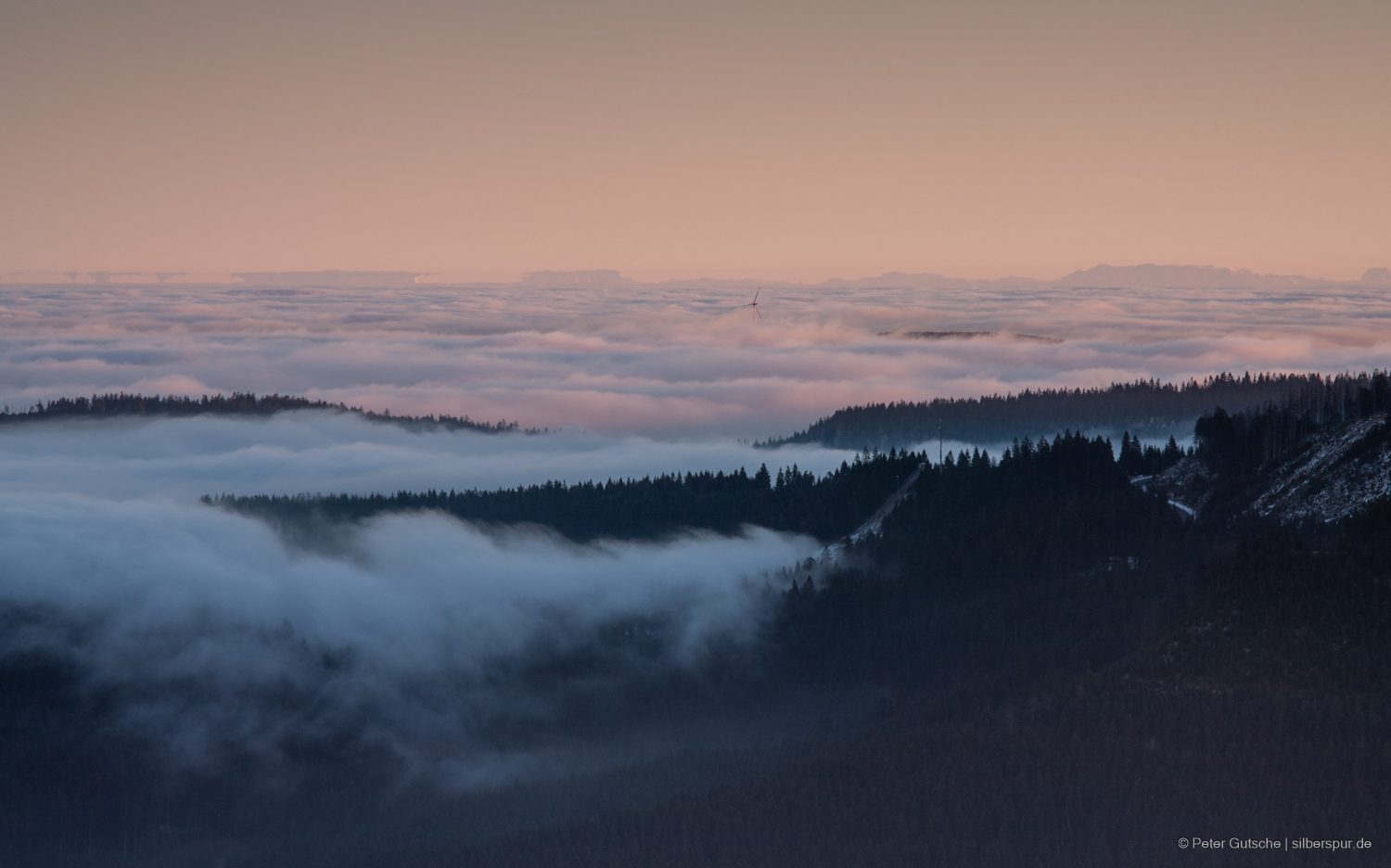
We are standing at a viewpoint at the highest point of the Northern Black Forest, approximately 1150 meters above sea level. Since the fog limit is around 1000 meters, nearly all the other mountains in the Black Forest visible from here are below the fog line. The lone wind turbine rising above the sea of fog is located near the Alexanderschanze, close to the village of Kniebis, at an altitude of about 900 meters.
What you see at the horizon above the sea of fog are not clouds but the distorted shapes of the far chain of the Swiss Alps.
The distortion changed with time. The following photo was taken at 17:34.
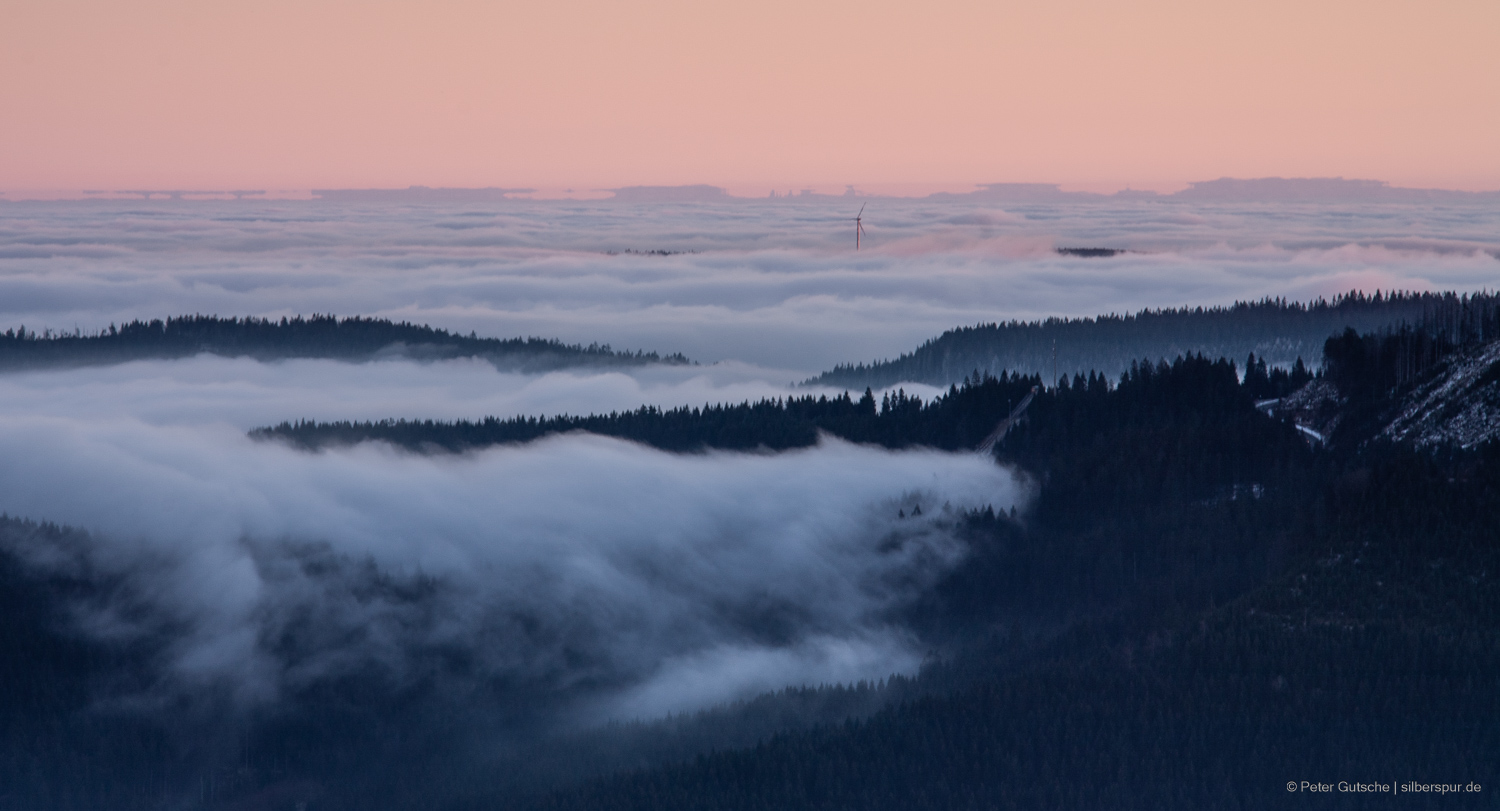
This is a panorama with a larger section of the Alps panorama, taken at 17:38.
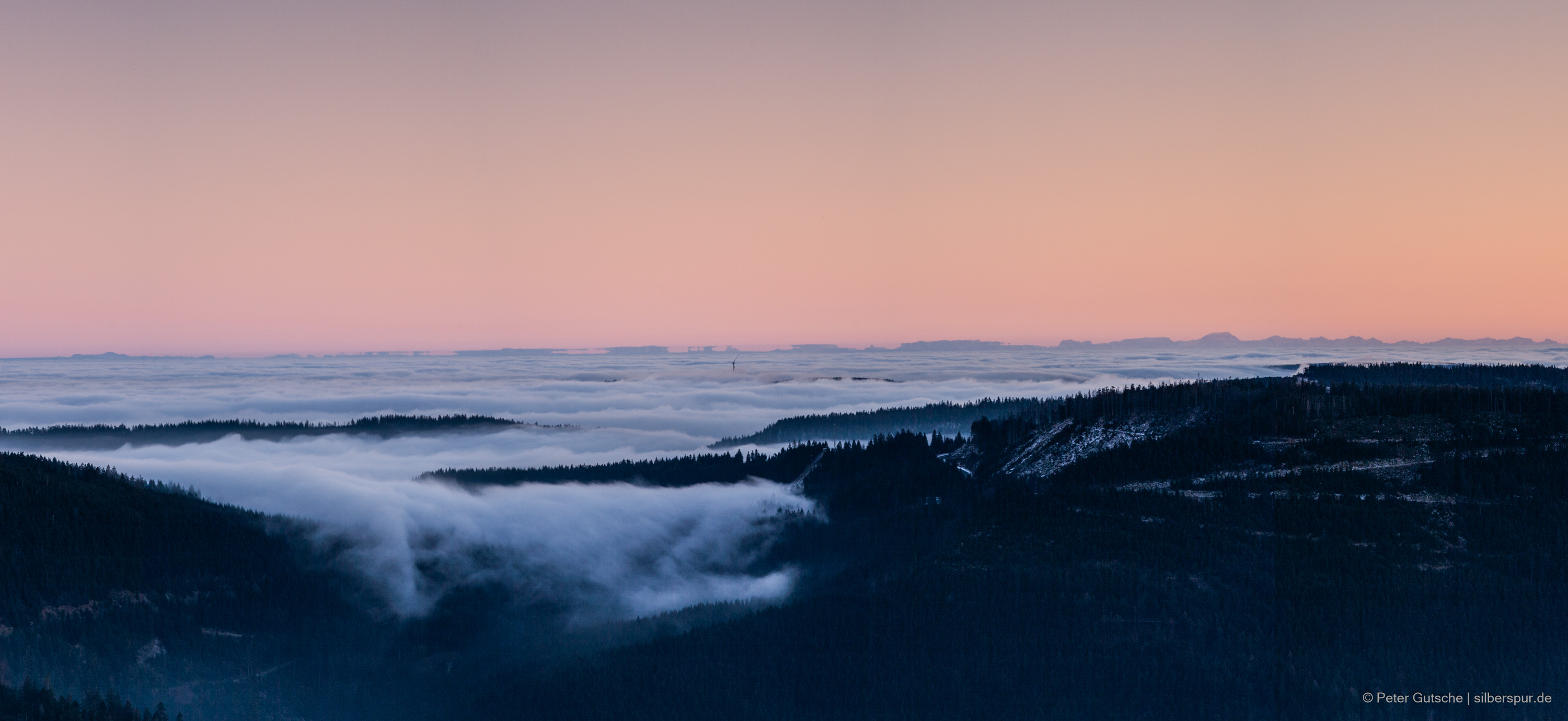
And, finally, this is a panorama taken even later when the mirages have vanished, the photo was taken at 18:23.
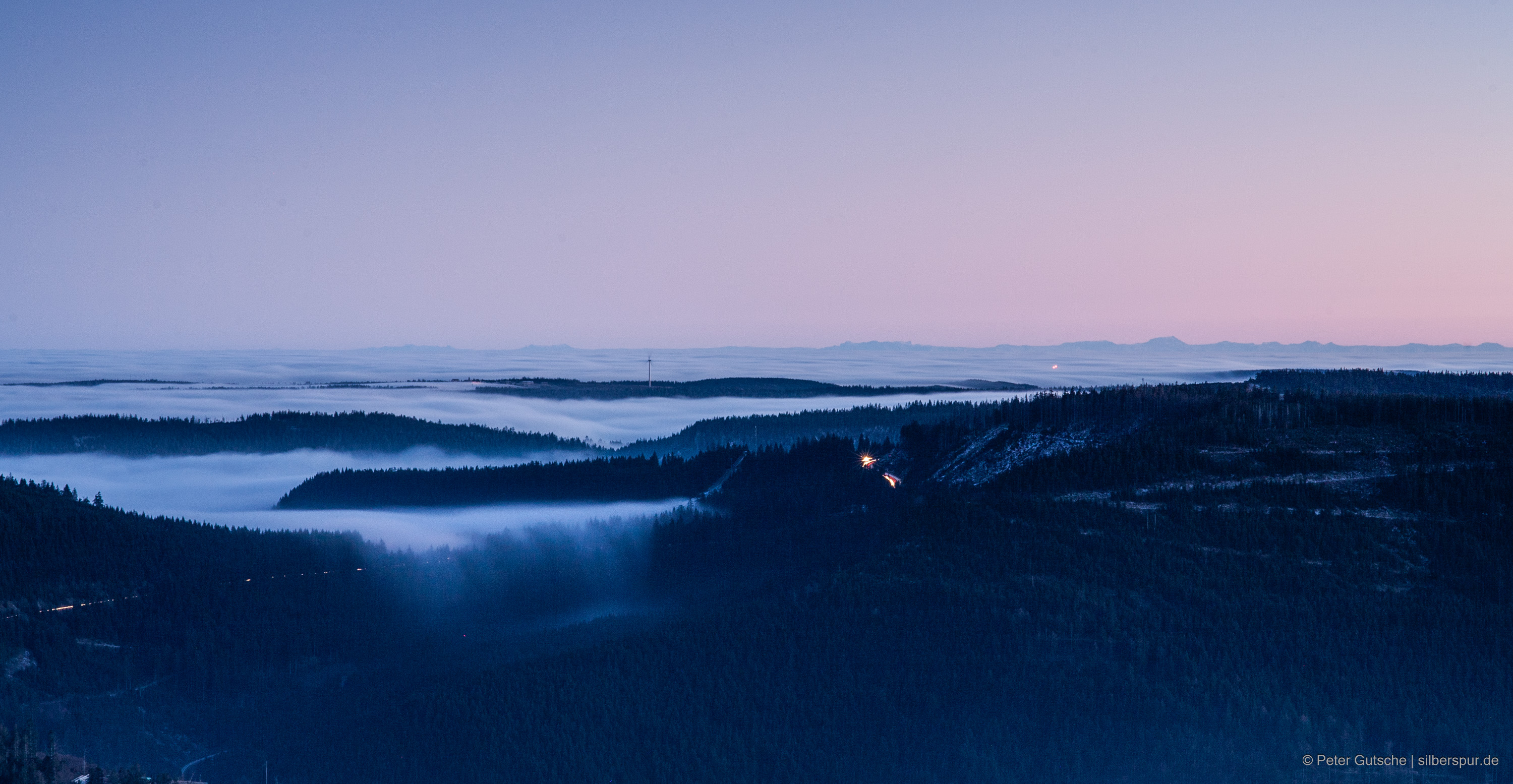
To compare the mountain range with and without mirages, I have put the two latest panoramas in one frame with some major peaks indicated (also identified using the program provided by Dr. Ulrich Deuschle).
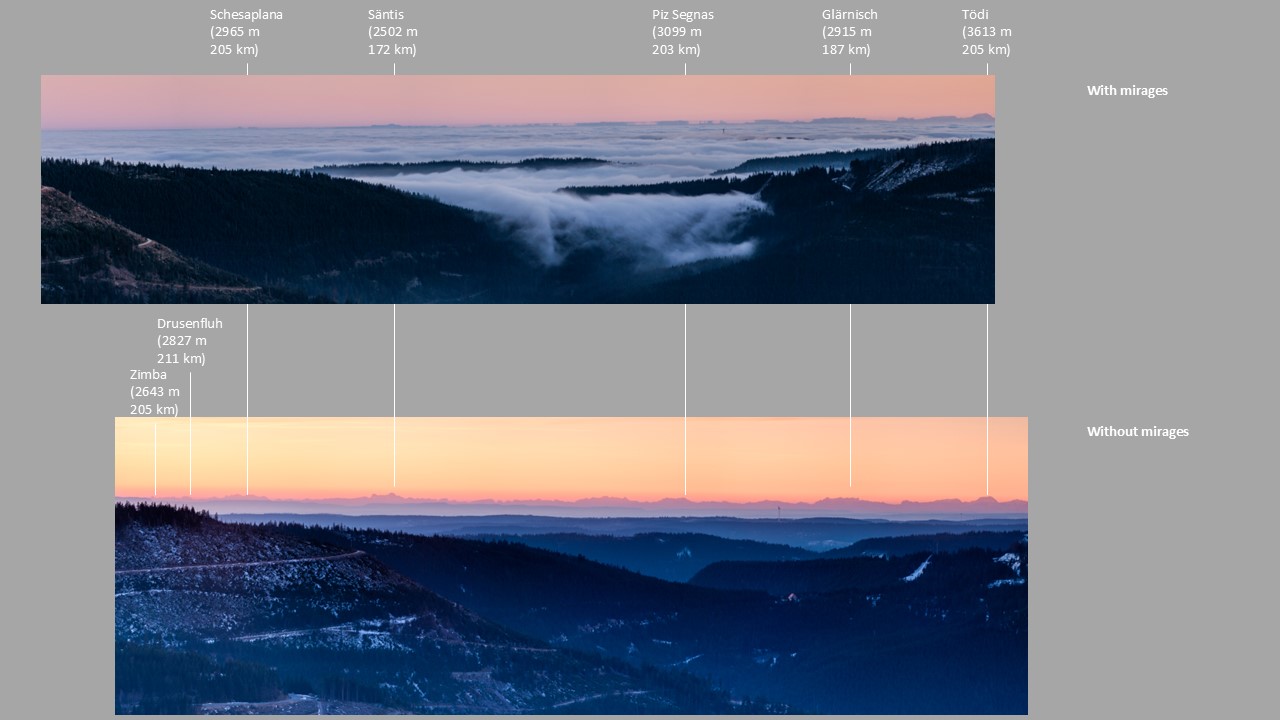
The upper image shows the panorama as distorted due to mirages (this image was taken at the same day as the other shown above). The below image shows nearly the same panorama which I have taken from a standpoint not exactly the same but near to the one which I have taken for the upper image. The lower image was taken shortly before sunset and shows the undistorted Alpine panorama and allows you to identify some major peaks ranging from the Zimba in the Austrian Verwall region up to the Tödi in central Switzerland. That means, the silhouettes of the Alps can still be compared and single summits can be identified.
The end
Unlike what the Goethe quote at the beginning might have led you to suspect, I have not shown you a single image of an inferior mirage in this blog post; instead, I have shown many of superior mirages. With a bit of imagination, one could perhaps say that some of the photos presented here occasionally depict a „Streif erlogner Berge“ (streak of illusory mountains).
I hope I have given you an idea of what mirages are and inspired you to watch for this optical phenomenon while hiking or traveling.